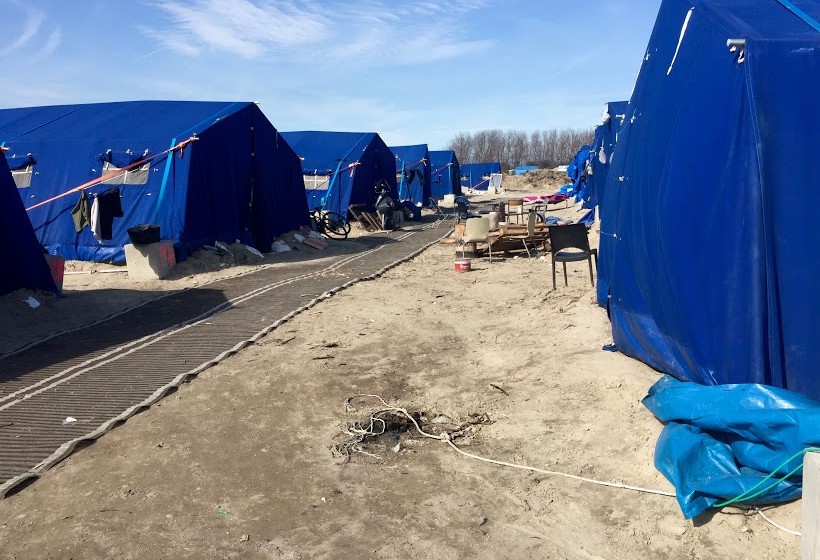On Friday, February 29, 2016, ruthless riot police backed by court order demolished tents and huts in the southern portion of the Calais refugee camp. Or, alternatively, vigilant riot police stood guard as the French government sought to improve living standards by moving refugees to converted shipping containers or other accommodation centers. That day in late February marked the beginning of violent skirmishes between police and refugees in the French port town of Calais. As the demolitions unfolded, police fired tear gas at refugees, while refugees threw stones at officers and set shelters on fire to disrupt demolitions.
Successive attempts to demolish squalid parts of the camp have been met with criticism and resistance. Refugees and migrants are fearful of moving to the much-vaunted facility of converted shipping containers. The area remains fenced off from the rest of the camp, lacks communal spaces, and requires refugees to scan their hands to enter and leave — a feature they fear will force them to stay in France. Many refugees and migrants have also refused to move to other parts of France to seek asylum as they fear this will jeopardize their ability to eventually reach Britain. Even as the narrative surrounding the demolitions remains in dispute among refugees, NGOs, French natives and government officials, the government intended to dismantle most of the “jungle” before the end of March. The exact timeline for demolitions remains in flux.
I traveled to the Calais migrant and refugee camp from March 14 to 16, together with a humanitarian student group from Brasenose College that collected donations and supplies to aid local NGOs with clothing and basic medical supplies. This article is based on my impressions of the camp and interviews with the migrants, refugees and NGO workers.
A central paradox that characterizes Calais is the determination shown by migrants and refugees to seek asylum in Britain despite opportunities and encouragement to do so in France. Many wish to reunite with family members who are already in Britain. An Egyptian migrant named Youssef, who had come to Calais seven months prior, worked in Athens and Argos for four years before deciding to join his brother in Manchester, even though he had a job in Greece. Others know they will find greater opportunities to work on the black market in Britain than elsewhere in Western Europe. Still, others idealize Britain as a welcoming place that will not reproduce the police brutality and discrimination they faced in France. While they wait to be welcomed by Britain or smuggled to its shores, the refugees and migrants endure difficult living conditions and damage to their dignity.
The road that leads to the Calais “jungle” runs parallel to train tracks in the midst of an industrial zone. The front and back entrances to the camp are guarded by dozens of riot police, though access to the camp is generally unrestricted. The southern portion of the camp, demolished by bulldozers and various fires, is jarring—a wasteland of dirt and abandoned clothes and supplies that once belonged to a large migrant and refugee community. The only structures left standing in this portion of the camp are “social” structures” like St. Michael’s Ethiopian Orthodox Church, the camp’s legal center, the “Jungle Books” library, child and adult language schools, and a cabin that houses Iranian hunger strikers who sewed their mouths shut earlier this month in protest of the demolitions. The section of the camp set aside for children and families who are housed in donated caravans has been moved further north. In addition, a gated area in the northernmost section of the camp, known as the Jules Ferry Center, provides overnight accommodations for women and children, showers and meals.
The northern section of the camp remains intact, and many people displaced by demolitions in the south picked up tents and huts to carry them to the north. The camp is home to 3,700 or 5,500 migrants (figures are disputed between Calais officials and NGOs) mainly from the Middle East, Afghanistan and Africa who traversed Europe in hopes of reaching Britain through the Channel connecting Calais and Dover. The vast majority of the migrants and refugees I encountered were men between the ages of 18 and 40. Many are well-educated and belonged to their countries’ middle classes before fleeing their homes. Some sold property and belongings to pay smugglers for passage through Europe, but even a fee of £5,000 or £10,000 does not guarantee safe passage to Britain. One young man I met from al-Manajir in northern Syria, a village the Kurds contested and won back from ISIS, paid a smuggler £10,000 for passage to Britain. Ari has an uncle in London who owns a pastry shop selling baklava and has promised Ari a job at his shop.
Ari’s story is typical of others in the camp. Transition and dynamism characterize daily life at the camp. In the three days I spent there, the government ordered the entire back road of the camp to be paved with new asphalt. During the day, the camp is relatively quiet as the men sleep and rest in preparation for the night, at which point they attempt to cross the channel on ferries to Britain, sometimes multiple times a night. Most men who attempt the journey are caught and brought back to the camp, but the hope laid bare in the title of this piece keeps the men going.
The man who uttered the phrase, “To be alive is to have hope,” was unusual in his entrepreneurial spirit and determination to seek asylum in Britain. A former print shop owner in Iran, the man, who asked not to be named, changed his name and identity in the hope that an Afghan identity would improve his case in seeking asylum. Like many others in the camp, he spent his afternoons and evenings in migrant- and refugee-owned restaurants and cafes that line the main dirt road. Vendors bake fresh bread on demand for 50 Euro cents. A typical lunch is comprised of rice, beans and cabbage. In the late afternoon and evening, the restaurants are filled with migrants and refugees of all backgrounds. Perched on top of benches and reclining against the walls of the restaurant structure, migrants and refugees converse, drink black coffee or milk tea, and watch Indian and Eastern European music videos on a large flat screen. The restaurants have electric plugs where the men charge their smart phones. Theirs is a life of patient expectation followed by hapless attempts to break through the barrier that separates them from their idealized destination.
That is not to say the camp is always peaceful. Originally self-segregated into various areas with people of their own nationality, migration from the southern portion of the camp has forced people of different national, ethnic and sectarian origins to intermingle. The close proximity and resource constraints have led to intermittent violence among the migrant and refugee groups. Shortly before I arrived, a fight had broken out between neighboring Egyptian and Sudanese community members when a fire set by the Sudanese to celebrate a family’s successful arrival in Britain spread to Egyptian huts. The incident created sufficient pretext and chaos to exacerbate existing competition between the two communities. Similar violent clashes have unraveled between Afghan and African migrants and refugees.
Despite its best efforts to contain the human crisis unfolding in Calais, the government has failed to achieve a satisfactory resolution. The policy of demolishing existing wretched living conditions and expanding new infrastructure has not kept up with the continuous flow of new migrants and refugees seeking to cross the channel. Furthermore, there does not appear to be a long-term policy in either the French or the British political establishment to tackle the problem. So, while European governments struggle with the challenges of managing and integrating the influx of refugees from the Middle East and North Africa, migrants and refugees stranded in Calais will continue to seek asylum in Britain.






